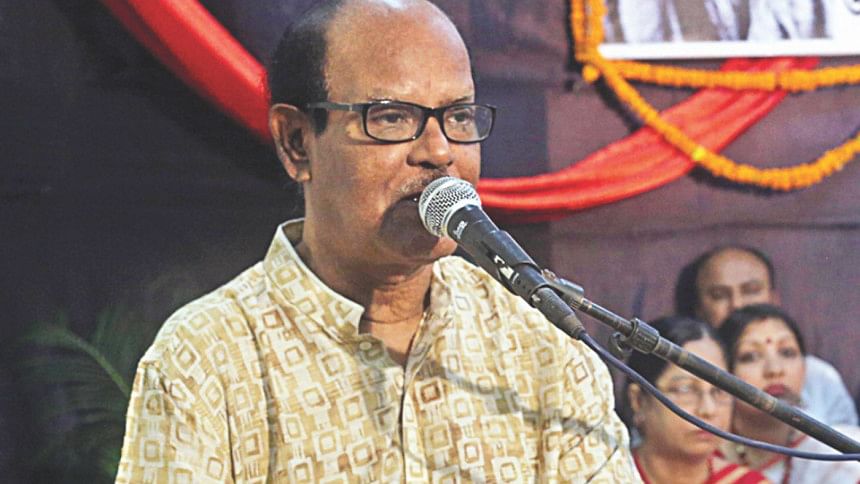Mihir Kumar Nandi: Life dims for a luminary

Ustad Mihir Kumar Nandi, one of the most prominent figures of Chittagong's musical and cultural movement, is in critical condition.
The veteran Rabindra Sangeet singer and classical vocalist is suffering from cancer. He is in life support at a private medical clinic in the port city.
He was diagnosed with the disease six months back, Shila Momen, a long-time associate of Mihir Nandi, informed The Daily Star.
“He was diagnosed with liver cancer when he went to Kolkata for treatment of other ailments. He had surgery there and was doing better after chemotherapy. But there was a relapse recently and when he went back to Kolkata the doctors informed him that the cancer had spread to his colon,” she said. They did not consider further surgery and only prescribed medications. Earlier this month he had to be hospitalized after his condition deteriorated.
Born on December 14, 1945 in Keuchia village of Chittagong's Satkania to Fanindra Lal Nandi and Mallika Rani Nandi, Mihir Kumar Nandi got his first music lessons from his father, but later came under the tutelage of Waheedul Haque and Acharya Shailada Ranjan Majumder for Rabindra Sangeet. He was also a disciple of Ustad Nirod Baran Barua and Pandit Ashok Dasgupta for violin, Sangeetacharya Soumitra Lal Dasgupta for dhrupad vocals and Ustad Aditya Narayan Das for tabla, sitar and esraj.
His musical career began when he enlisted as a singer with Chittagong Betar in 1964, and started teaching Rabindra Sangeet and classical music a couple of years later. He also served as a part time teacher at the Chittagong University's music department, and as a jury member of Bangladesh Television and Bangladesh Betar's special grade artiste, music director and composer.
He worked at the Bangladesh Chemical Industries Corporation as a senior officer, but music was where his heart was. One of the foremost exponents of the cultural revolution in Chittagong in the late '60s, he was a frontline campaigner of the cultural front of the 1969 mass uprising.
Mihir Nandi was an integral part of the Shadhin Bangla Betar Kendra in the tumultuous days of 1971 where inspirational and patriotic songs found a voice in him to boost the spirit of the Freedom Fighters, and the refugees in the camps in India.
After Bangladesh's liberation, Mihir Nandi concentrated on building up and flourishing the practice of pure music in the port city. He founded a music school, Ananda Dhwani and was closely involved with cultural organisations like Chittagong Arya Sangeet Samiti, Udichi and Rabindra Sangeet Sammilan Parishad. He was one of the forerunners of the first Pahela Baishakh celebrations in Chittagong in 1978 where it is still held every year.
For his contribution to music, Mihir Nandi was awarded the Shilpakala Padak 2015 by the Bangladesh Shilpakala Academy.
“One of the special things about Mihir mama is his socio-political consciousness. I have known him since 1968-'69, and since then he was a leader of the cultural movement against the Pakistan government, when he hung a harmonium from his neck and sang on the streets,” said Shila. Musical exponents are usually not too politically inclined usually, but he was a leader of the progressive cultural movement in Chittagong.
While Dhaka has long been the epicenter of Bangladesh's cultural practices, there are people spread all across the country who have dedicated their lives to upholding our culture and passing it on from one generation to the next. These luminaries often remain beyond public and mainstream media attention and it is only when they pass away are their contributions recognised.
In a rather conservative region like Chittagong, Mihir Kumar Nandi fought and overcame many obstacles for decades to spread music and cultural practices that will probably remain uncovered. But the man that he is, Mihir Nandi would probably not care for a heroic reception and recognition; the facts that his life's work bore fruit and his music would live on through his students and colleagues, probably bring him more satisfaction than column inches of a newspaper dedicated to him.

 For all latest news, follow The Daily Star's Google News channel.
For all latest news, follow The Daily Star's Google News channel. 



Comments